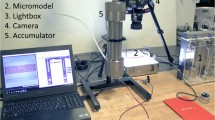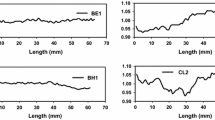Abstract
The flow properties of complex fluids through porous media give rise to multiphase flow displacement mechanisms that operate at different scales, from pore-level to Darcy scale. Experiments have shown that injection of oil-in-water emulsions can be used as an effective enhanced-oil recovery (EOR) method, leading to substantial increase in the volume of oil recovered. Pore-scale flow visualization as well as core flooding results available in the literature have demonstrated that the enhanced recovery factor is regulated by the capillary number of the flow. However, the mechanisms by which additional oil is displaced during emulsion injection are still not clear. In this work, we carried out two different experiments to evaluate the effect of emulsion flooding both at pore and macro scales. Visualization of the flow through sand packed between transparent plexiglass parallel plates shows that emulsion flooding improves the pore-level displacement efficiency, leading to lower residual oil saturation. Oil recovery results during emulsion flooding in tertiary mode (after waterflooding) in parallel sandstone cores with very different absolute permeability values prove that emulsion flooding also leads to enhancement of conformance or volumetric sweep efficiency. Combined, the results presented here show that injection of emulsion offers multiscale mechanisms resulting from capillary-driven mobility control.
Similar content being viewed by others
References
Allan F.M., Kamel M.T., Mughrabi T.A., Hamdan M.H.: Infiltration of oil into porous sediments. Appl. Math. Comput. 177, 659–664 (2006)
Babadagli T.: Development of mature oil fields—a review. J. Pet. Sci. Eng. 57, 221–246 (2007)
Bai, B., Han, M., Li, Y., Wei, W., Gao, Y., Cost, J.-P.: Selective water shutoff technology study and application of W/O emulsions. In: SPE/DOE 59320. Proceedings of the 24th SPE/DOE Symposium on IOR, Tulsa, OK, USA, pp. 1–7 (2000)
Cobos S., Carvalho M.S., Alvarado V.: Flow of oil–water emulsions through a constricted capillary. Int. J. Multiph. Flow 35, 507–515 (2009)
Dullien F.A.L.: Porous media-fluid transport and pore structure. Academic Press, New York (1992)
Hofman J.A.M.H., Stein H.N.: Permeability reduction of porous-media on transport of emulsions through them. Colloids Surf. 61, 317–329 (1991)
Homsy G.M.: Viscous fingering in porous media. Annu. Rev. Fluid Mech. 19, 271–311 (1987)
Idowu N.A., Blunt M.J.: Pore-scale modelling of rate effects in waterflooding. Transp. Porous Media 83, 151–169 (2010)
Khambhratana, F., Thomas, S., Ali, S.M. Farouq.: Macroemulsion rheology and drop capture mechanism during flow in porous media. In: SPE 48910. Proceedings of the 1998 SPE Conference and Exhibition in China, Beijing, China, pp. 657–665 (1998)
Lake L.: Enhanced Oil Recovery. Prentice Hall, Englewood Cliffs (1989)
McAuliffe C.D.: Crude-oil-in-water emulsions to improve fluid-flow in an oil reservoir. J. Pet. Technol. 25, 721–726 (1973)
Ouyang Y., Mansell R.S., Rhue R.D.: Emulsion-mediated transport of nonaqueous-phase liquid in porous-media—a review. Crit. Rev. Env. Sci. Technol. 25, 269–290 (1995)
Payatakes A.C.: Dynamics of oil ganglia during immiscible displacement in water-wet porous media. Ann. Rev. Fluid Mech. 14, 365–393 (1982)
Romero M.I., Carvalho M.S., Alvarado V.: Experiments and network model of flow of oil–water emulsion in porous media. Phys. Rev. E 84, 046305 (2011)
Sahimi M.: Flow and transport in porous media and fractured rock. VCH, Boston (1995)
Sorbie K.S.: Polymer Improved Oil Recovery. CRC Press, Buca Raton (1991)
Tallakstad K.T., Knudsen H.A., Ramstad T., Løvoll G., Måløy K.J., Toussaint R., Flekkøy E.G.: Steady-state two-phase flow in porous media: statistics and transport properties. Phys. Rev. Lett. 102, 074502 (2009)
Valavanides M.S., Constantinides G.N., Payatakes A.C.: Mechanistic model of steady-state two-phase flow in porous media based on ganglia dynamics. Transp. Porous Media 30, 267–299 (1998)
Wang, D., Cheng, J., Yang, Q., Gong, W., Li, Q.: Viscous–elastic polymer can increase microscale displacement efficiency in cores. In: SPE 63227. Proceedings of the 2000 SPE Annual Technical Conference and Exhibition, Dallas, TX, pp. 1–10 (2000)
Author information
Authors and Affiliations
Corresponding author
Rights and permissions
About this article
Cite this article
Guillen, V.R., Carvalho, M.S. & Alvarado, V. Pore Scale and Macroscopic Displacement Mechanisms in Emulsion Flooding. Transp Porous Med 94, 197–206 (2012). https://doi.org/10.1007/s11242-012-9997-9
Received:
Accepted:
Published:
Issue Date:
DOI: https://doi.org/10.1007/s11242-012-9997-9




